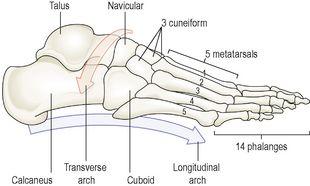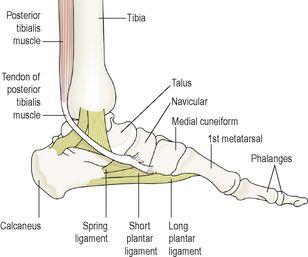Ross & Wilson Anatomy and Physiology in Health and Illness (186 page)
Read Ross & Wilson Anatomy and Physiology in Health and Illness Online
Authors: Anne Waugh,Allison Grant
Tags: #Medical, #Nursing, #General, #Anatomy

The fibula is the long slender lateral bone in the leg. The head or upper extremity articulates with the lateral condyle of the tibia, forming the proximal tibiofibular joint, and the lower extremity articulates with the tibia, and projects beyond it to form the
lateral malleolus
. This helps to stabilise the ankle joint.
Patella (knee cap)
This is a roughly triangular-shaped
sesamoid
bone associated with the knee joint. Its posterior surface articulates with the patellar surface of the femur in the knee joint and its anterior surface is in the
patellar tendon
, i.e. the tendon of the quadriceps femoris muscle.
Tarsal (ankle) bones (
Fig. 16.41
)
The seven tarsal bones forming the posterior part of the foot (ankle) are the talus, calcaneus, navicular, cuboid and three cuneiform bones. The talus articulates with the tibia and fibula at the ankle joint. The calcaneus forms the heel of the foot. The other bones articulate with each other and with the metatarsal bones.
Figure 16.41
The bones of the foot.
Lateral view.
Metatarsals (bones of the foot) (
Fig. 16.41
)
These are five bones, numbered from inside out, which form the greater part of the dorsum of the foot. At their proximal ends they articulate with the tarsal bones and at their distal ends, with the phalanges. The enlarged distal head of the 1st metatarsal bone forms the ‘ball’ of the foot.
Phalanges (toe bones) (
Fig. 16.41
)
There are 14 phalanges arranged in a similar manner to those in the fingers, i.e. two in the great toe (the
hallux
) and three in each of the other toes.
Arches of the foot
The arrangement of bones in the foot, supported by associated ligaments and action of associated muscles, gives the sole of the foot an arched or curved shape (
Figs 16.41
and
16.42
). The curve running from heel to toe is called the
longitudinal
arch, and the curve running across the foot is called the
transverse
arch.
Figure 16.42
The tendons and ligaments supporting the arches of the left foot.
Medial view.
In the normal longitudinal arch, only the calcaneus and the distal ends of the metatarsals should touch the ground, the bones in between lifted clear. This gives a conventional footprint shape. If, however, the concavity of the sole is lost because of sagging ligaments or tendons, the arch sinks and much more of the sole of the foot is in contact with the ground: this is called flat foot. Because the arches of the foot are important in distributing the weight of the body evenly whilst upright, whether stationary or moving, the flat foot loses the springiness of normal foot structure and leads to sore feet when standing, walking or running for long periods. As there are movable joints between all the bones of the foot, very strong muscles and ligaments are necessary to maintain the strength, resilience and stability of the foot during walking, running and jumping.
Posterior tibialis muscle
This is the most important muscular support of the longitudinal arch. It lies on the posterior aspect of the lower leg, originates from the middle third of the tibia and fibula and its tendon passes behind the medial malleolus to be inserted into the navicular, cuneiform, cuboid and metatarsal bones. It acts as a sling or ‘suspension apparatus’ for the arch.
Short muscles of the foot
This group of muscles is mainly concerned with the maintenance of the longitudinal and transverse arches. They make up the fleshy part of the sole of the foot.
Plantar calcaneonavicular ligament (‘spring’ ligament)
This is a very strong thick ligament stretching from the calcaneus to the navicular bone. It plays an important part in supporting the medial longitudinal arch.
Plantar ligaments and interosseous membranes
These structures support the lateral and transverse arches.
Joints
Learning outcomes
After studying this section you should be able to:
state the characteristics of fibrous and cartilaginous joints
list the different types of synovial joint
outline the movements possible at five types of synovial joint
describe the structure and functions of a typical synovial joint.
describe the structure and movements of the following synovial joints: shoulder, elbow, wrist, hip, knee and ankle.
A joint is the site at which any two or more bones articulate or come together. Joints allow flexibility and movement of the skeleton and allow attachment between bones.
Fibrous joints
The bones forming these joints are linked with tough, fibrous material. Such an arrangement often permits no movement. For example, the joints between the skull bones, the
sutures
, are completely immovable (
Fig. 16.43
), and the healthy tooth is cemented into the mandible by the periodontal ligament. The tibia and fibula in the leg are held together along their shafts by a sheet of fibrous tissue called the interosseous membrane (
Fig. 16.40
). This is a fibrous joint that allows a limited amount of movement and stabilises the alignment of the bones.



